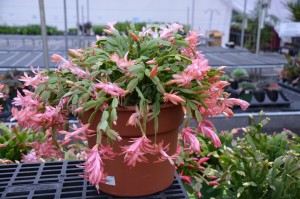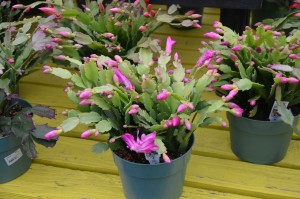Thanksgiving cactus (Schlumbergera truncata) and Christmas cactus (S. bridgesii) are popular fall- and winter-flowering houseplants. Flower colors (by variety) include red, purple, lavender, cream, and white.
Holiday cacti thrive in hanging baskets. The scalped stems and foliage start out growing vertically and weeks later begin to spill over the edge of the pot. Plants flourish for many years if these simple care tips are followed.
Fall-Winter Care In Your Home: Place in bright light in an east or south facing window for maximum flower numbers. Avoid cold, drafty areas close to window or near a dry heat source. Increase room humidity by sitting the pot on a tray of moist gravel, but do not allow bottom of container to stand in water.
After bloom finishes, prune back stems to develop a bushier plant. Feed monthly with a water soluble fertilizer such as Miracle-Gro™, Peters™, Nature’s Source™, or Schultz™ at one-half package directions.
Spring-Summer Outdoors: Move plant outside once night temperatures remain above 45°F. Avoid placing cactus in direct sunlight. Over the first 1-2 weeks, acclimate the plant to outdoor temperature, light, and wind. If leaf edges start to redden, move plant to a shadier spot. Increase frequency of watering, particularly when rainfall is lacking.
Feed holiday cactus every 2-3 weeks with a water soluble fertilizer at full label rates. This is during the periods of active spring/summer growth and full bloom indoors.
To Initiate Holiday Blooms: In early to mid-October, place cactus in the dark for 12 hours daily, such as in a closet from 8 p.m. to 8 a.m. over 6 to 8 consecutive weeks. An alternative method is to chill the plant in temperatures between 50 – 55°F at night. This may be done outdoors, weather permitting. Don’t subject plant to temperatures below 40°F.
Holiday cacti are not desert cacti, but true epiphytic succulents that live in the shade of Brazilian tropical rain forests. They have high water and humidity needs. Drought is taboo to these plants; drought symptoms include shriveled scalped leaves and blooms and buds drop off. Plants need to be watered regularly, at least weekly. Plant(s) should be repotted annually, usually in March, into a larger pot containing a well-drained potting media, preferably one designated for succulents. After potting, prune the plant back by at least one-half and encourage good branch symmetry around pot.



 Posted in
Posted in 
